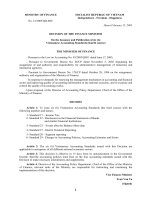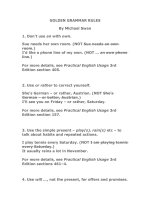Decision Rules doc
Bạn đang xem bản rút gọn của tài liệu. Xem và tải ngay bản đầy đủ của tài liệu tại đây (198.04 KB, 32 trang )
© Harry Campbell & Richard Brown
School of Economics
The University of Queensland
BENEFIT-COST ANALYSIS
BENEFIT-COST ANALYSIS
Financial and Economic
Financial and Economic
Appraisal using Spreadsheets
Appraisal using Spreadsheets
Ch. 3: Decision Rules
Applied Investment Appraisal
Conceptualizing an investment
as:
•
a net benefit stream over time, or, “cash flow”;
•
giving up some consumption benefits today in
anticipation of gaining more in the future.
+
_
time
$
A project as a cash-flow:
Although we use the term “cash flow”, the dollar values used
might not be the same as the actual cash amounts.
•
In some instances, actual ‘market prices’ do not reflect the true
value of the project’s input or output.
•
In other instances there may be no market price at all.
•
We use the term ‘shadow price’ or ‘accounting price’ when
market prices are adjusted to reflect true values.
Three processes in any cash-flow analysis
•
identification
•
valuation
•
comparison
Conventions in Representing Cash Flows
•
Initial or ‘present’ period is always year ‘0’
•
Year 1 is one year from present year, and so on
•
All amounts accruing during a period are assumed to fall on last
day of period
B
1
B
2
0 1 2
year
+
_
Graphical Representation of Cash Flow Convention
Figure 2.4
•
We cannot compare dollar values that accrue at different
points in time
•
To compare costs and benefits over time we use the concept
“discounting”
•
The reason is that $1 today is worth more than $1 tomorrow
WHY?
Comparing Costs and Benefits
Discounting a Net Benefit Stream
Year 0 1 2 3
Project A -100 +50 +40 +30
Project B -100 +30 +45 +50
WHICH PROJECT ?
Deriving Discount Factors
•
Discounting is reverse of compounding
•
FV = PV(1 + i)
n
•
PV = FV x 1/ (1 + i)
n
•
1/ (1 + i)
n
is the Discount Factor
Using Discount Factors
•
If i = 10% then year 1 DF = 1/(1+0.1)
1
= 0.909
•
PV of $50 in year 1 = $50 x 0.909 = $45.45
What about year 2 and beyond?
•
PV of $40 in year 2 = $40 x 0.909 x 0.909
= $40 x 0.826 = $33.05
•
PV = $30 in year 3 = $30 x 0.909
3
= $30 x 0.751 = $22.53
Calculating Net Present Value
Net present value (NPV) is found by subtracting the discounted
value of project costs from the discounted value of project
benefits
Once each year’s amount is converted to a discounted present value
we simply sum up the values to find net present value (NPV)
NPV of Project A
= -100(1.0) + 50(0.909) + 40(0.826) + 30(0.751)
= -$100 + 45.45 + 33.05 + 22.53
= $1.03
Using the NPV Decision Rule for Accept
vs. Reject Decisions
•
If NPV ≥ 0, accept project
•
if NPV < 0, reject project
Comparing Net Present Values
Once each project’s NPV has been derived we can compare them by
the value of their NPVs
•
NPV of A = -100 + 45.45 + 33.05 + 22.53
= $1.03
•
NPV of B = -100 + 27.27 + 37.17 + 37.55
= $1.99
As NPV(B) > NPV(A) choose B
Will NPV(B) always be > NPV(A)?
Remember, we used a discount rate of 10% per annum.
Changing the Discount Rate
As the discount rate increases, so the discount factor
decreases.
•
Remember, when we used a discount rate of 10% per annum
the DF was 0.909.
•
If i = 15% then year 1 DF = 1/(1+0.15)
1
= 0.87
This implies that as the discount rate increases, so the NPV
decreases.
•
If we keep on increasing the discount rate, eventually the NPV
becomes zero.
•
The discount rate at which the NPV = 0 is the “Internal Rate of
Return” (IRR).
The NPV Curve and the IRR
Where the NPV curve intersects the horizontal axis gives the
project IRR
Figure 2.5:
NPV
Discount rate
NPV curve
IRR
The IRR Decision Rule
•
Once we know the IRR of a project, we can compare this
with the cost of borrowing funds to finance the project.
•
If the IRR= 15% and the cost of borrowing to finance the
project is, say, 10%, then the project is worthwhile.
If we denote the cost of financing the project as ‘r’, then the
decision rule is:
•
If IRR ≥ r, then accept the project
•
If IRR < r, then reject the project
NPV vs. IRR Decision Rule
With straightforward accept vs. reject decisions, the NPV and IRR
will always give identical decisions.
•
If IRR ≥ r, then it follows that the NPV will be > 0 at discount
rate ‘r’
•
If IRR < r, then it follows that the NPV will be < 0 at discount
rate ‘r’
WHY?
Graphical Representation of NPV and
IRR Decision Rule
Figure 3.0
r %
NPV
A
20%
$425
0
$181
10%
Using NPV and IRR Decision Rule to
Compare/Rank Projects
Example 3.7: IRR vs. NPV decision rule
IRR NPV(10%)
0 1 2 3
A -1000 475 475 475 20% $181
B -500 256 256 256 25% $137
•
If we have to choose between A and B which one is best?
Switching and Ranking Reversal
•
NPVs are equal at 15% discount rate
•
At values of r < 15%, A is preferred
•
At values of r > 15%, B is preferred
•
Therefore, it is safer to use NPV rule when comparing or
ranking projects.
r %
NPV
A
20%
$425
0
$181
10% 15%
$137
25%
B
Figure 3.1
Choosing Between Mutually Exclusive Projects
•
IRR (A) > IRR (B)
•
At 4%, NPV(A) < NPV (B)
•
At 10%, NPV(A) > NPV (B)
In example 3.8, you need to assume the cost of capital is:
(i) 4%, and then,
(ii) 10%
Other Problems With IRR Rule
•
Multiple solutions (see figure 2.8)
•
No solution (See figure 2.9)
Further reason to prefer NPV decision rule.
Figure 2.8 Multiple IRRs
25 100
400
NPV
r %
Figure 2.9 No IRR
NPV
r %
Problems With NPV Rule
•
Capital rationing
–
Use Profitability Ratio (or Net Benefit Investment Ratio (See Table 3.3)
•
Indivisible or ‘lumpy’ projects
–
Compare combinations to maximize NPV (See Table 3.4)
•
Projects with different lives
– Renew projects until they have common lives: LCM
(See Table 3.5 and 3.6)
– Use Annual Equivalent method (See Example 3.12)
Using Discount Tables
•
No need to derive discount factors from formula - we use
Discount Tables
•
You can generate your own set of Discount Tables in a
spreadsheet
•
Spreadsheets have built-in NPV and IRR formulae:
Discount Tables become redundant









